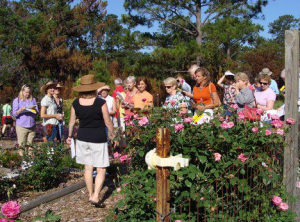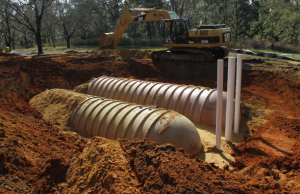Through the use of cutting-edge energy and water technologies combined with educational outreach, Leon County, Fla., has transformed a 50-year-old building—the Leon County Cooperative Extension Office—into a state-of-the-art Sustainable Demonstration Center. The center has been certified as a Zero-Net Energy facility by the New Buildings Institute, Vancouver, Wash., becoming one of only seven retrofitted buildings in the nation with this distinction and the only local government facility. In addition to the 13,500-square-foot building producing as much energy as it consumes, cisterns store 400,000 gallons of rainwater annually captured from its roof, which is reused for onsite irrigation.

from the demonstration center’s roof and held underground in repurposed tanks until irrigation is needed. The stored rainwater then is pumped onto the center’s landscape, which consists of demonstration gardens where Florida-friendly landscaping principles are shared.
The Sustainable Demonstration Center focuses on water conservation and energy production and savings and then shares the lessons it gleans from its conservation efforts with the community.
Step One: Water
In an effort to reduce the need for potable water and offset the building’s stormwater impacts, the center’s rooftop was converted into a rainwater collection system. Four 10,000-gallon fiberglass tanks were buried onsite and connected with the roof. These tanks were destined for the landfill after providing petroleum storage but were creatively repurposed for this sustainable cause.
Captured rainwater is held underground in the repurposed tanks until irrigation is needed, at which time the stored rainwater is pumped onto the center’s landscape, which consists of demonstration gardens where Florida-friendly landscaping principles are shared. The design and construction of the water system was performed entirely by Leon County staff. County Public Works employees excavated large pits for the cisterns, and facility crewmembers designed and installed the collection system, pumps and electrical components.
Leon County discovered it had developed a novel approach to the underground storage elements, water treatment, pumping and electrical controls for this project. As a result, provisional patents have been obtained.
The industrial patent application asserts 19 claims covering the capture, filtering, storage and distribution of water to landscaped areas. Rain is initially filtered from the rooftop through screened roof gutters and then diverted into conventional downspouts channeling the rain to a PVC collection pipe system that is located along the lower perimeter of the building. PVC piping in varied diameter and slope facilitates the transport of rainwater from the building perimeter to a system smart box, where even more particulates are filtered from the rainwater. The smart box further regulates flow into the retrofitted fiberglass storage tanks.
The smart box maintains consistent water levels in the tanks; when water levels are too high, the water is allowed to escape to the surrounding wooded areas. In addition, the tanks work with a municipal water source as an alternate source of irrigation during periods of low rainfall. All the tanks are looped together, thus all the tanks must be empty before the alternate water source is activated. The submersible well pulls water through a final filtering apparatus, consisting of a hydro-dynamic centrifugal filter and series of ultra-fine polishing filters, which remove even the smallest debris ensuring the drip-irrigation system will not clog.
The center’s four storage tanks operate in pairs. Each pair has a 1.5-horsepower pump and an air bladder to pressurize it to 35 to 85 psi for the irrigation system. The objective of this system is to utilize readily available rainwater, thus decreasing the consumption of utility-treated water for landscape irrigation.
To further minimize utility-treated water use, the center currently is retrofitting the restrooms for


1 Comment
More great modeling of the sustainable mindset. Conserving resources for the future.